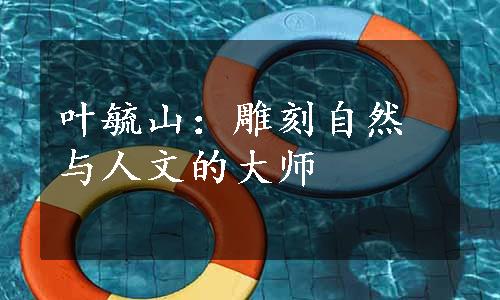
Ye Yushan, a master who sculpted natural and cultural works
叶毓山的名字在雕塑界无人不知。北京毛主席纪念堂的那尊汉白玉毛主席坐像,便是他的手笔。
1935年,叶毓山出生在德阳的一个普通家庭。1951年考入成都艺专(后改为四川美术学院),读了三年国画专业后转到了雕塑专业。他时常跟着导师前往大足石刻观摩,从传统的中国佛教造像中汲取营养。1960年,在考入中央美院读研时,他又全面学习法国雕塑艺术。
1961年,中国革命军事博物馆向全国雕塑家征集创作《毛主席全身雕像》,当时投稿的作品很多,大多都是毛主席端坐或者挥手的造型,但叶毓山觉得,这尊雕像应该凸显毛主席高瞻远瞩、胸中自有雄师百万的革命英雄气概。他的投稿是毛主席的立像,负手而立,眺望远方,神态十足。军博最终定下了这个作品,叶毓山用数个月的时间完成了雕塑,技惊四座。然而此时,他还未毕业。1976年,毛主席逝世,党中央决定在天安门广场修建毛主席纪念堂,其中需要放置一尊雕像。叶毓山星夜兼程赶往北京,最终拔得头筹。
叶毓山广泛地临摹和创作,他如苦行僧一般徒步在敦煌莫高窟、龙门石窟,茂陵、顺陵、霍去病墓等古迹,这些遗迹给他深深的震撼,由此逐渐形成他独特的风格。他特别强调充分尊重石头的特性,在雕刻过程中去呈现石材本身的线条和形态。他的许多作品乍一看去似乎就是一块不经雕琢的原石,然而仔细一看,顿生惊艳之感。其作品《大江东去——苏东坡》便是如此。他常说一句话:“石刻的过程中要不失时机地适可而止,不然因雕琢过头而出现的遗憾会让人后悔莫及。”在他最具影响力的代表作《歌乐山烈士群雕》创作中,主体人物左脸颊部分在石头打制过程中被崩下一大块。但他发现,正因为这种缺失反而强化了人物的情绪,这个“意外”成为雕塑最具表现力的部分。他的雕塑强调大的气势和轮廓,他更看重雕塑整体上所呈现出来的气质和精神。
叶毓山作品
A sculpture by Ye Yushan
叶毓山还是一名教育家。他担任四川美术学院院长十三年。他开阔的视野,宽厚的胸怀,敏锐的艺术感受,具有针对性的教学方法对四川美院的发展起到重要作用。(www.xing528.com)
叶毓山一生热爱雕塑,他的工作室设在双流。2017年1月7日,他因病去世,川渝文化美术界、相关人士以及叶老弟子和学生,纷纷赶赴双流悼念。
Ye Yushan was born into an ordinary fam ily in Deyang in 1935. In 1951, he enrolled in Chengdu Art School(later renamed Sichuan Fine Arts Institute) where he majored in traditional Chinese painting for three years before changing his major to sculpture. In 1960, Ye enrolled in a postgraduate program at the Central Academy of Fine Arts(CAFA) to study the art of French sculpture.
In 1961, the M ilitary Museum of the Chinese People’s Revolution solicited creations for the Statue of Chairman Mao Zedong from sculptors across China. Ye Yushan stood out as the w inner w ith a standing statue. In 1976, after Chairman Mao had passed away, the CPC Central Comm ittee decided to build the Chairman Mao Memorial Hall on Tian'anmen Square. Again, the work of Ye was chosen.
Ye Yushan laid a particular emphasis on full respect for the traits of rocks in the sculpting process, so that the existing lines and shapes of the rocks can be better shown. He often said, “A sculptor should know when and where to stop in carving a rock; otherw ise going toofar w ill lead to regrets.” He emphasized the overall force and contour, and valued the temperament and spirit presented by a sculpture as a whole.
Ye was also an educator. He served as Director of Sichuan Fine Arts Institute(SFAI) for 13 years. His broad vision, open-m indedness, artistic acumen and targeted teaching approach were important to the development of SFAI.
Ye Yushan devoted his life to sculpture. His studio was in Shuangliu. He died of illness in Shuangliu on January 7, 2017. The cultural and art circles of Sichuan and Chongqing, relevant persons, and Ye’s disciples and students traveled to Shuangliu to pay their tributes and condolences.
免责声明:以上内容源自网络,版权归原作者所有,如有侵犯您的原创版权请告知,我们将尽快删除相关内容。




